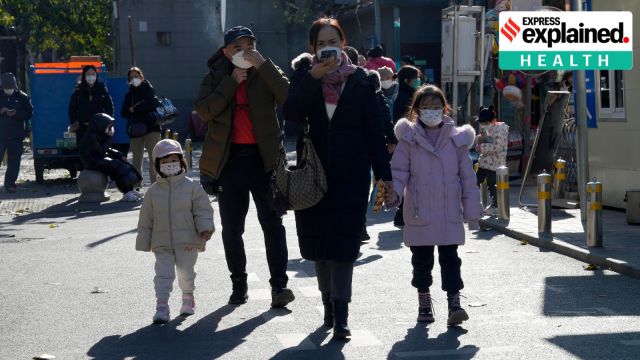China pneumonia outbreak: Here’s everything we know
China pneumonia outbreak: Is this some new disease? Who is affected? Why the outbreak now? Most importantly, do you need to be worried?
 Residents wearing masks pass by a children's hospital in Beijing, Friday, Nov. 24, 2023. Chinese officials say they did not detect any "unusual or novel diseases" in the country, the World Health Organization said Thursday, following an official request by the UN health agency for information about a potentially worrying spike in respiratory illnesses and clusters of pneumonia in children. (AP Photo/Ng Han Guan)
Residents wearing masks pass by a children's hospital in Beijing, Friday, Nov. 24, 2023. Chinese officials say they did not detect any "unusual or novel diseases" in the country, the World Health Organization said Thursday, following an official request by the UN health agency for information about a potentially worrying spike in respiratory illnesses and clusters of pneumonia in children. (AP Photo/Ng Han Guan) Evoking feelings of déjà vu among people across the world, China is seeing a spike in respiratory illnesses as it enters its first full winter season after lifting Covid-19 restrictions last December. Here is what we know about the situation so far.
1. So, what exactly is happening?
There has been a spike in reported incidents of respiratory illnesses in China. First reported by China’s National Health Commission on November 13 in a press conference, the illnesses have caused a surge in hospitalisations, with many hospitals warning of long waits. The situation came into the spotlight this week when the WHO asked China for more information, citing a report by the Program for Monitoring Emerging Diseases (ProMED) on clusters of undiagnosed pneumonia in children.
2. Where is this spike occurring?
Infections have proliferated across China’s north-eastern regions, with Beijing and Liaoning, 800 km apart, being two major hubs. “One major hospital in Beijing has reported that on average every day, they are seeing about 1,200 patients enter their emergency room,” Al Jazeera reported on Thursday.
3. Who have been most affected by the outbreak?
Cases among children are especially high, with children making up a large proportion of those hospitalised. Schools in Beijing are reporting high levels of absenteeism, even dismissing entire classes for at least a week if some students are ill.
Some experts have noted that the high incidence in children is actually a positive, indicating that older individuals have some immunity to the pathogens running rampant. This would most likely mean that existing vaccines are likely to help protect individuals from disease. However, apart from children, the elderly and pregnant women may also be vulnerable.
4. Is this the outbreak of a new disease, like Covid-19 a few years back?
No, not as far as we know yet. Chinese authorities have attributed the increase in incidence of respiratory illnesses to the circulation of known pathogens such as influenza, mycoplasma pneumoniae, respiratory syncytial virus (RSV), and SARS-CoV-2 (the virus that causes COVID-19). So far, no new illness has been identified, although the World Health Organization has asked China for more disease data.
According to WHO, mycoplasma pneumoniae, a common bacterial infection which typically affects younger children, is likely to be what is affecting most of the patients under 18.
5. Why this outbreak now?
Chinese authorities, and many health experts elsewhere, have attributed the outbreak to the lifting of Covid-19 restrictions, similar to “lockdown exit waves” seen in other countries. China may be repaying an “immunity debt” after their strict and lengthy lockdown, “which must have drastically reduced the circulation of respiratory bugs and hence decreased immunity to endemic bugs”, Francois Belloux, director of University College London’s Genetic Institute, wrote on Twitter.
Moreover, the onset of winter is a likely culprit as well. Chinese authorities have said that temperatures will further plummet this weekend onwards.
6. How are authorities dealing with the outbreak?
While they have stopped short of reintroducing full-blown Covid-19-era restrictions, Chinese authorities have asked the public to step up vigilance, and take preemptive measures. The WHO, in a statement, made the following recommendations: “keeping distance from people who are ill; staying home when ill; getting tested and medical care as needed; wearing masks as appropriate; ensuring good ventilation; and regular hand-washing.”
7. How is the Chinese public dealing with the situation?
While masking up and taking basic precautions, most seem to not be unduly worried about the outbreak. Parents in Shanghai on Friday told Reuters that they expected the tide to blow over soon. “It’s not that bad, there are more children falling sick now but it’s mainly an issue of protection,” one mother said. Most want to continue with their lives as usual.
8. But are things likely to get better any time soon?
No. Chinese authorities have said that influenza would peak this winter and in spring, with mycoplasma pneumoniae continuing to be high in some areas in the future. They have also warned of the risk of a rebound in Covid-19 infections, and asked for strengthening the reporting process.
9. So, should you be worried about this outbreak in India?
No. Not yet, at the very least. First of all, the outbreak remains fairly contained for the time being. Though a full lockdown has not been imposed, China has ramped up testing and surveillance. Given the experience of the pandemic a couple of years back, authorities are likely to be doubly cautious.
Second, even if the outbreak spreads beyond China’s borders, from what we know about it so far, we are likely to have vaccines and medicines readily available to fight it. For instance, mycoplasma pneumonia can be treated with the antibiotic Azithromycin.
The world is a very different place than it was in 2019-20. The traumatic experience of the global pandemic continues to trigger paranoia about the ‘next Covid-19’ across the world. But globally, we are far better placed today to deal with such infectious diseases due to the very same experience.
- 01
- 02
- 03
- 04
- 05






































